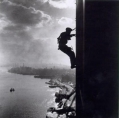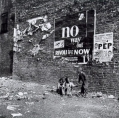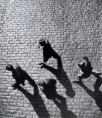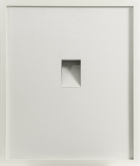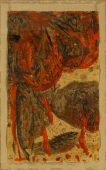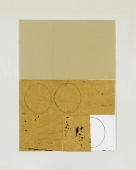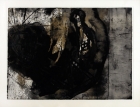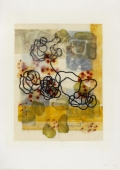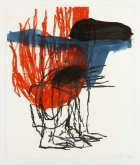
Artist | Bedrich Grünzweig (*1910)
https://www.artist-info.com/artist/Bedrich-Gruenzweig
About the work (deutsch / english)
About the work (deutsch / english)
in focus Galerie am Dom, Köln, zeigt vom 15. September bis zum 20. Oktober 2000 erstmalig in Westeuropa und in Deutschland eine große Retrospektive des. Amerikaners Bedrich Grünzweig (geb. 1910 in Prag), der in diesem Jahr seinen 90. Geburtstag feierte.
1939 verließ Bedrich Grünzweig Prag wegen der Judenverfolgung durch die Nationalsozialisten und wanderte in die USA aus. Seit Ende der vierziger Jahre fotografierte Grünzweig das Leben in New York. Er suchte dieselben Orte auf, welche dem Fotoliebhaber durch die Arbeiten Weegees und D. j. Ruzickas vertraut sind. Auf seinem eigenen schöpferischen Weg verarbeitete er die Einflüsse sowohl der klassischen Fotografie als auch des Bauhauses - das lässt sich beispielsweise in dem Bild 'Home from Work' nachvollziehen, das, von oben fotografiert, vier Männern mit ihren Schatten zeigt. Ebenso fühlt er sich dem Fotojournalismus von 'Harper's Bazaa'r und 'Life' verbunden. Als er 1951 den ersten Preis von U.S. Camera für sein Bild 'Between Heaven and Earth' erhielt, bestätigte dies seine Überzeugung von der Bedeutung des Fotografierens. Mit Ausnahme solcher Fotos von Architektur und Stadtansichten, die sich jeweils auf eine ästhetische Gegebenheit konzentrieren, fand er seine Motive meist in der unmittelbaren Umgebung. Wenn er Lebendes fotografierte, tat er dies ohne zu inszenieren. Er gestaltete das Bild rein kompositorisch. In seinen Stilleben (z.B. 'Home Town Newspapers' und 'New shopping Market~ arbeitete er kreativ mit visuellen Effekten. Die Titel seiner Arbeiten betonen die jeweilige Stimmung des Bildes, wie etwa bei 'April Shower' und 'Snow Storm'. Nach seinen eigenen Worten strebte er danach, "die lebendige Atmosphäre der Situation mit [dem] eigenen Erleben zu verknüpfen". Er beschreibt dies als "emotionale Identifikation und Durchdringung". "Man kann nicht eine vertrauliche und intensive Situation ohne Verständnis und Sympathie einfangen" sagt er. Trotz der Zeitlosigkeit seiner Sichtweise, ist diese verknüpft mit den Besonderheiten der jeweiligen Zeit - dem sozialen Klima, dem herrschenden Stil, den konkreten Gegenständen der Umgebung. Daraus hat sich eine einzigartige und unwiederholbare Bildsprache entwickelt."
Im Jahr 1947 begann er für die UN zu arbeiten. Er war dort unter anderen verantwortlich für die Herstellung von Dokumentarfilmen. Während des Jahres 1961 schickte ihn die UN als Leiter der Friedenserhaltungskommission nach Afrika, in den vormals belgischen Kongo. Grünzweig widmete sich dort fotografisch weniger mit der Darstellung sozialer Verhältnisse und ethnischer Konflikte. Das waren Themen des Dokumentarfilms. Ihn, den Fotografen interessierten andere Dinge. Er ging morgens zum Markt, nahm am Karneval teil und sah die Freuden im Leben der Menschen. "Ich wollte zeigen," sagt er, "dass das Glück überall gefunden werden kann, auch unter widrigen Umständen." (1)
Diese Reisen waren für ihn beruflich und privat stets sehr inspirierend. Während dieser Reisen - etwa nach Israel, Mexiko oder Spanien - zeigten sich in seinen Bildern zunehmend dokumentarische Qualitäten. Seine fotografischen Serien wurden einheitlicher. Gleichwohl konnten die Bilder auch einzeln bestehen, sei es in Zusammenhang mit den Anderen oder für sich. "Sein Anliegen ist weniger das Darstellen oder Berichten von Ereignissen als vielmehr das Wachrufen von Gefühlen und Gedanken beim Betrachter." (2)
Nach dreißig Jahren in der Fremde kehrte Grünzweig erstmalig nach Prag zurück. Insgesamt vier mal reiste er in die Tschechische Republik, zuletzt 1991. Sieben Jahre später zeigte er in Prag erstmalig seine Bilder. Dies war eine besondere Form der Rückkehr. Das künstlerische Werk Bedrich Grünzweigs überblickt die zurückliegende Zeit, von politischen und sozialen Wirren unbelastet. Es zeugt von einer reifen Persönlichkeit, die feinfühlig ihre Umgebung wahrnimmt.
(1) Aus Jolarn Havelkovás Gespräch mit Bedrich Grünzweig in New York im Dezember 1997
(2) Josef Moucha, Zpátky v Praze (Zurück in Prag), Poutník s kameru. Archiv 1948 - 96, Praha 1998 (Katalog).
Catalogue
Bedrich Grünzweig - Between Haeven and Earth / Mezi Nebem a Zemi; 41 full page illustrations, 92 pages, text by Jolana Havelková, prepared by Jolana Havelková and Jiri Holna; Published by Kovalam, Prague 8
in focus Galerie am Dom, Marzellenstraße 9, D-50667 Köln
DM 38,- / Euro 19,45
About Bedrich Grünzweig
Bedrich Grunzweig intentionally chose the Czech Republic for a retrospective of his life's work. It is where he was born, and if the Nazis had not occupied the area in those former years, he would likely never have left. He still remembers a sign that was above the window on the building where he lived with his parents on the riverbank in Prague: it said, "Love other countries, but stay home". Grünzweig managed to escape Czechoslovakia before the Holocaust, unlike his parents and his brother. After planning in secret for several months, he hastily and quietly left his homeland, without even the chance to say goodbye to his family. He and his wife made their way to the United States, where they settled permanently. He never saw his parents, his brother or his grandmother, again. Throughout his life, he has been pursued by a sense of personal guilt that he was the only one in his family to survive.
While until recently he was virtually unknown as a photographer in the Czech Republic, his roots have led him back to his homeland. It is a place where he has many good friends, both from the times he spent there, as well as from when he worked with the International Center of Photography in New York. At the ICP he came to know some visiting Czech theorists and photographers. The first exhibition of his photographs in Prague (1998) presented work from 1948-1996. While Grünzweig was involved in the realm of photography for many years, he never did it professionally. For him, photography was a life-long interest.
Bedrich Grünzweig spent his childhood and youth in Brno, where his family moved from Prague, and where his father became chief engineer at the Krá1ovopolská machine works. He remembers learning about violence at an early age. In the period after Archduke Franz Ferdinand's assassination in Sarajevo, which brought about the fateful events of 1914, he remembers nights when he could hear shooting in the streets. The shots were not all that loud, but they left a deep impression on a child who did not yet know about war.
His father's interests in astronomy, music, and photography influenced Grünzweig considerably, yet it was only after his arrival in the United States that he began to photograph seriously. The pictures he took during his years in Czechoslovakia were usually for the family album; he recalls taking his first picture, a portrait of his brother, in 1926. He was in Brno at the same time as photographer Jiri Sever (1904-1968), who was then just starting out, as well as members of the Photo Group of Five (J. Kamenický, B. Nemec, J. Nohel, E Povolný, H. Táborský). Although he may have had the chance to meet with them, such an occasion never came about. He did, however, often meet with Vi1ém Reichmann (1908-1991). "Willi [Vilém] lived close to us," he recalls, "we went to the same high school. I thought of him often during the Czech Modernism exhibition at the ICP, and I wrote to him right away. After that we exchanged a few letters." (1)
As a student, Grünzweig enjoyed the carefree life customary to children whose families are well-off and comfortably positioned in society; he frequented coffee-houses with his friends and classmates. His father, a Jewish intellectual, and a Renaissance man living steeped in the traditions of the Austrian monarchy, enabled and encouraged him to study in Vienna. There, Grünzweig studied French, English, and Law.
An important stage in his life came later, when he worked in a sugar factory in Ratbor by Kolín (near Prague). It was there that he had a chance to talk with ordinary people, and to become aware of their daily concerns and of village life. He gained substantial experience there, learning to listen to people, to sympathize, and to share their experiences with them. Later on, wherever he took pictures, he often captured the common situations of peoples' lives.
Upon his arrival in New York, Grünzweig was amazed by the architecture, by the exhausting pace of life, and by the special atmosphere that possibly only that city can offer. Suddenly he found himself in a completely different world, with much larger cultural opportunities than he had known before. He began to teach himself about art and photography. At that time he bought his first camera, a Rolleiflex, from Ilsa Hofmann, also from his homeland. This coincidence he regarded as a happy omen.
In 1940, he acquired his first Job at the Czechoslovak pavilion of the World's Fair in New York. Among other things, he was responsible for the projection of an anti-Nazi film called 'Crisis'. Here he first met its author, Alexander Hackenschmied, otherwise known as Sasha Hammid (born 1907), a filmmaker and avant-garde photographer. To this day, they are still friends. "I knew of Sasha's name back in Zlín [Czechoslovakia]" he says. "Many years later we met in America. After six months of watching his film, I couldn't stand to see it anymore - it was shown the whole time, every day... But to be serious now, Sasha is an exceptionally accomplished person... Thanks to him I met many people - photographer Jan Lukas, for example." (1)
Since the late 1940s, Grünzweig has been photographing life in New York. He went to the same places that are very familiar to photography lovers through the images of Weegee ('Coney Island') and D. J. Ruzicka ('Brooklyn Bridge'). While Grünzweig has taken his own creative path, influenced by classical photography, he admits to the influence of the Bauhaus. (This is most recognizable in 'Home from Work', the image of four men and their shadows, photographed from above). He also recognizes a kinship with the photojournalism of Harper's Bazaar and Life magazines. When, in 1951, he received the U.S. Camera first prize for his image 'Between Heaven and Earth', it deepened his con-viction in the meaning of taking photographs. With the exception of his photographs of architecture and urban sites, which focus on esthetic arrangement, he mostly captures the immediate situations that occur around him. When he photographs live subjects they are unaltered - he just arranges the picture compositionally. With still life or static motifs (e.g. 'Home Town Newspapers', 'New Shopping Market') he relies on creative visual effect. The titles of his pictures sometimes serve to emphasize the particular mood of the image, such as with 'April Shower' and 'Snow Storm'. "In his own words, his motive and challenge have been to 'capture live the atmosphere of a setting, and to join that testimony with [his] own experience.' He describes this as 'emotional identification or integration'. 'One cannot capture an intimate, intense scene without understanding and sympathy,' he says. While his perspective is timeless, it still meshes with the characteristics of specific eras - the social atmosphere, the prevailing styles of the time, or the physical objects of a setting. What results is the formation of a unique and unrepeatable iconography."(2)
Grünzweig's connection with art took him not only to galleries, but also to clubs and theatres. In these settings he took pictures mostly of the social life, but he also tried to make his way backstage. At a variety of events, he acquired numerous documentary portraits of well-known personalities, Leonard Bernstein, Mare Chagall, Marcel Marceau, Rudolf Serkin, Ravi Shankar and others. He photographed his friend Egon Hostovský for the cover of the book, The Charity Ball.
Despite, or perhaps because of, all that he has experienced, his view of the world is a positive one. He is a witty speaker and storyteller. It is important for him to view even unfortunate situations with perspective. Cornell Capa of the ICP says of Grünzweig: "Through his life span he has seen much. He has gentle humour, and great sensitivity to the human tragedy." In response to humorous, sometimes even touchingly comical situations, Grünzweig expresses himself through both images and words. Such situations are the theme of his 'Unbelievable Pictures' series, which is the work of several years.
In 1947, after many years of experience with the Czech Information Service, he began to work for the United Nations, for whom, among other things, he was responsible for the production of documentary films. It gave him the opportunity to work with well-respected film-makers such as Ladislav Kolda, Alexander Hammid, and Frank Herman. Between them, they made a series of films - stories from Japan and India, and profiles of notable people. Hammid and Kolda made a film about cellist Casals, for example.
In 1961, the UN sent him to work in Africa as manager of peace-keeping operations in the former Belgian Congo. Rather than documenting social conditions and conflicts between ethnic groups as is common with documentary films, Grünzweig, as a photographer, paid attention to different things. He went to the market in the mornings, he visited carnivals, and he looked for joy in people's lives. "I wanted to show," he says, "that happiness can exist anywhere, in all sorts of conditions."
Whether professional or private, these travels have always been very inspirational for him. On his travels (Israel, Mexico, Spain and others), his photographs often acquire a more documentary quality. His photographic series become more consolidated, yet their individual images can also exist on their own, with or without the context of the others. "His primary aim is not to document or report information, but to evoke an emotive, thoughtful response in the viewer." (2)
Grünzweig returned to Prague for the first time thirty years after departing his homeland. He visited the places of his youth, the apartment where he lived with his family, and also the Jewish town, which made him recall all that he had lost. He took pictures of the little streets there, the architecture, the interiors of the synagogues, and the Jewish cemetery. More than taking pictures of Prague, Grünzweig wanted mostly to soak up the atmosphere of the place from which he had been disconnected for so long. "The experience tore at my heart," he says of his first time back. "The city itself was more beautiful than I remembered it, yet I found myself in what felt like a cold, foreign place. There was no one I could talk to besides the guides in museums and the waiters in restaurants."
In all, Grünzweig has returned to the Czech Republic four times, the last in 1991. Seven years later, he was represented in Prague by his photographs, which marked another return. The artist's work surveys the time that has passed by in a way that is mostly unencumbered by political and social problems. It gives the testimony of a mature individual who sensitively perceives what is around him.
(1) From Jolana Havelková's interview with Bedrich Grünzweig in New York (December 1997).
(2) Josef Moucha, Zpdtky v Praze (Back in Prague), Poutník s kamerou. Archiv 1948-1996, Praha 1998 (catalogue).
Biography
Biography
1910 Born April 3, in Prague. Father, Ludvik Grünzweig, (born 1874), a military officer, and chief engineer at Královopolská machine works. Mother, Ida Bondyová, (born 1878), stayed home.
1912 The Grünzweig family moves to Brno, (his parents and brother Jan, 3 years Bedrich's elder).
1920 - 28 Grünzweig attends high school in Brno.
1928 - 30 College for International Economics in Vienna (Hochschule für Welthandel).
1930 - 32 Attends Technical College in Brno, specializes in textile industries. Also works with Fritch & Co. Textile company.
1932 - 34 Compulsory military service in Uherské Hradiste, Officer training school in Olomouc, reaches rank of lieutenant.
1934 - 39 Acquires managerial position at the sugar factory in Ratbor near Kolín.
1938 Marries teacher Judita Wintersteinovd.
1939 Bedrich and Judita leave Czechoslovakia for the USA, and settle in New York.
1940 First job in U.S. at the Czechoslovak pavilion at the New York World's Fair; Grünzweig is responsible for film projection, visual media, news events, exhibitions and administration.
1941 - 47 Works for the Czechoslovak Information Service in New York. His job includes working with film and photographs and assembling general information. Here he comes into contact with many notable people from Czechoslovakia, including V. Fischl, A. Hoffmeister, E. Hostovský, J. Masaryk, A. Pelc, J. Voskovec, J. Werich.
1942 Bedrich's father dies in the Terezín concentration camp; his grandmother dies en route to Terezín. His mother is taken to Estonia, then later executed near Riga. His brother and sister-in-law are deported to Poland (Auschwitz concentration camp), where they, too, perish.
1943 Bedrich and Judita's daughter, Ruth, is born.
1947 Acquires American citizenship.
1947 - 74 Works at the United Nations Department of Public Information as administrator, then in the Division of Broadcasting, Film, Television and Photographic Services. Participates in programs that support peacekeeping operations, human rights, decolonization, and economic and social development. His work takes him to San Francisco, Geneva, Paris, London, Rome, Jerusalem, Prague, Vienna, Mexico, Congo, Canada, and Jamaica.
1951 Wins U.S. Camera magazine first prize for his photograph 'Between Heaven and Earth'.
1955 Organizes commemorative exhibition for 10th anniversary of the UN in San Francisco.
1961 - 62 Manager of Peace-keeping Operations for the UN in Africa (former Belgian Congo, Leopoldville).
1964 Wins Saturday Review first prize for his photograph 'Kennedy Airport'.
1965 Curator of the UN's 20th anniversary exhibition in New York. Prepares a multilingual news report of Pope Paul VI's visit to the UN during his trip to the US
1969 Returns to Czechoslovakia for the first time after 30 years. (Subsequent visits in 1972, 1983, 1991. These are always combined with a visit to Israel.)
1974 - 94 Volunteer work for the International Center of Photography in New York, as assistant to executive director Cornell Capa. Participates in curatorial work and public speaking.
From 1974 travels widely: to Israel, Italy, France, Spain, Portugal, Greece, Turkey, Austria, Mexico, Puerto Rico, Jamaica, Canada...
Lives in New York.
Solo Exhibitions (selection)
Solo Exhibitions (selection)
1974 Jewish Museum, New York, USA
1975 Haifa University, Israel
1980 Museum of the Jewish Diaspora, Tel Aviv, Israel
1980 Community Center, Toronto, Canada
1980 Community Center, Vancouver, Canada
1980 Charter Oak Temple, Hartford, USA
1980 Jewish Museum, Philadelphia, USA
1984 International Center of Photography, New York, USA
1998 "U Recických" Photo Gallery, Prague, Czech Republic
1999 Galerie MK, Roznov pod Radhostem, Czech Republic
1999 Czech Centre Vienna, Austria
2000 in focus Galerie amDom, Cologne
Group Exhibitions (selection)
Group Exhibitions (selection)
1951 Photokina, Cologne, Germany
1952 International Photography Exhibition, Lucerne, Switzerland
1967 Expo, Montreal, Canada
1985 Neikrug Gallery, New York, USA
1988 - 89 Beijing Municipal Hall, China
Other exhibitions in the United States: Cleveland Community Center, Ohio; Newton Community Center, Massachusetts; Wave Hill Museum, New York; United Nations Head Office, New York.
Collections
Collections
Public Library, New York, USA
United Nations Photography Archives, New York, USA
Museum of Modem Art, New York, USA
International Center of Photography, New York, USA
Cooper-Hewitt Museum, New York, USA
Seagram's Photo Collection, New York, USA
Library for the Performing Arts, New York, USA
Jewish Museum, New York, USA
Israeli Museum, Jerusalem, Israel
University of Haifa, Israel
Museum of the Jewish Diaspora, Tel Aviv, Israel
Moravian Museum, Brno, Czech Republic
Various private collections
Published Photographs and Texts (selection)
Published Photographs and Texts (selection)
1951 U.S. Camera, No. 6, p. 31 (photograph).
1951 Rotary Service, No. 102, October (cover photograph).
1952 Photo Arts, March (photographic essay).
1955 Art Photography Magazine, August, p. 31-35 (photograph, text Tonight The Mood Is Blue).
1956 Art Photography Magazine, September (photograph, text Two Faces).
1960 Popular Photography, p. 33-35 (photograph, text It's Not An Art!).
1960 Camera 35, June/July (photograph, text Which Is The Moment?).
1960 Photography Magazine, London, November 216, p. 30-34 (photographs, text Humour In Photography).
1961 Camera, London, June, p. 25 (Show Case - photographs).
1963 Africa Report, No. 1, January (cover photograph).
1965 Saturday Review, January 2, p. 59 (photograph).
1965 The Times, London, No. 23. September (cover page photograph).
1965 Medical News Pictorial, p. 153-157 (photograph Images Of Spain).
1967 Time, January 13 (advertising picture for Volkswagen of America, Inc.)
1969 Medical News Pictorial, November, p. 119-122 (photograph with a text of Golden City).
1969 Medical News Pictorial, April, p. 135-139 (photograph Manhattan Visions).
1971 Present Tense Magazine, No. 4 (photograph, text Istanbul. Jewish Community Today).
1974 Present Tense Magazine, No. 2, p. 60-63 (photograph, text Return To Prague).
1979 Jewish Exponent. Friday, No. 6, March 30, p. 1-3 (photograph, text Journey To Prague).
1979 Medical News Pictorial, No. 12, December (photograph).
1980 Jewish Exponent, Friday, No. 16, p. 1-5 (photograph, text Ellis Island Revisited).
1980 Jewish Exponent. Friday, No. 21, July 25, p. 1-4 (photograph with a text of Legends of Jerusalem).
1983 Jewish Exponent, Friday, No. 46, January 28, p. 3-4 (photograph, text The Making Of A Mime).
1984 Psychology Today Magazine, February, p. 56-57 (photograph).
1985 The New York Times, Travel, October 6, p. 1, 15 (photograph).
Literature
Literature
Biberman, Jane: Photographer Creates a Monument to Those Who Died. Jewish Exponent. 1980, No. 8.
Schneiderman, S.L.: Jewish Prague: Yesterday and Today. Forward. September 1984, p. 5-6.
Morava, Tomás: Bedrich Grünzweig - fotografie mezi nebem a zemí. (Bedrich Grünzweig - Photography between Heaven and Earth.) Salon (Právo literary supplement) 5. 3. 1998, p. 2. Prehalova, Radka: U Recckých predstavují v tuzemsku málo známého fotografa Grünzweiga (U Recickyeh presents Grünzweig, a Photographer Unfamiliar to Most Here at Home.) MF Dnes (Prague). 12. 3. 1988, p. 5.
Vackovi, Jana: Bedrich Grünzweig U Recických. (Bedrich Grünzweig at the U Recických Gallery). Ha1ó noviny (Prague). 19. 3. 1998.
Chuchma, Josef: Grünzweig se výstavy v rodné vlasti nakonec dozil. (Grünzweig Lives to Exhibit in his Homeland). MF Dnes (Prague) 23. 3. 1988, p. 11.
HoIna, Jiff: Bedrich Grünzweig: Poutník s kamerou (Bedrich Grünzweig: Pilgrim with a Camera). Hospodárké noviny. 3. 4. 1988, p. 35.
Glueek, Grace: A Century's Worth of Efforts to Capture a City's Essence. The New York Times. 30. 10. 1998.
Moucha, Josef: Poutník s kamerou (Pilgrim with a Camera). Ateliér. 1998, No. 9, p. 7.
Stojnar, Pavel: Roznovská Galerie MK hostí fotografie Bedricha Grünzweiga. (Roznov Gallery MK hosts Bedrich Grünzweig.) MF Dnes (South eastern Morava). 27.2.1999, p. 3.
Bedrich Grünzweig - Between Haeven and Earth / Mezi Nebem a Zemi; 41 full page illustrations, 92 pages, text by Jolana Havelková, prepared by Jolana Havelková and Jiri Holna; Published by Kovalam, Prague 8
in focus Galerie am Dom, Marzellenstraße 9, D-50667 Köln
DM 38,- / Euro 19,45
Catalogues
Catalogues
Pilgrim With a Camera. Bedrich Grünzweig 1948-1996. Prague, U Recických Photo Gallery, PAIDEIA - Jiri
Jaskmanický 1998. Introductions by Jolana Havelková and Josef Moucha. (Named photographic publication of the year in the exhibition catalogue category by Fotografie-Magazín.)
Monogram for the Pilgrim With a Camera exhibition. Roznov pod Radhostemm, MKA 1999. Introductions by Bedrich Grünzweig and Jolana Havelková.
Television Programs
Television Programs
Jubilee. Artefakta. Czech TV 2/1998, Jiri Holna, director. (Documentary about A. Hammid.)
Pilgrim With a Camera. Artefakta. Czech TV 711998, Jiri Holna, director.
 offers / Requests offers / Requests  |
About this service |
|---|
 Exhibition Announcements Exhibition Announcements  |
About this service |
|---|
 Visualization |
Learn more about this service | ||
|---|---|---|---|

Interested in discovering more of this artist's networks?
3 easy steps: Register, buy a package for a visualization, select the artist.
See examples how visualization looks like for an artist, a curator, or an exhibition place: Gallery, museum, non-profit place, or collector.

Exhibition History

|
SUMMARY based on artist-info records. More details and Visualizing Art Networks on demand. Venue types: Gallery / Museum / Non-Profit / Collector |
||||||
| Exhibitions in artist-info | 2 (S 2/ G 0) |
Shown Artists - 0 of 0 artists (no. of shows) - all shows - Top 100 |
||||
| Exhibitions by type | 2: 2 / 0 / 0 / 0 | |||||
| Venues by type | 2: 2 / 0 / 0 / 0 | |||||
| Curators | 0 | |||||
| artist-info records | Sep 2000 - Jan 2001 | |||||
|
Countries - Top 1 of 1 United States (1) |
Cities 2 - Top of 2 New York (1) Köln (1) |
Venues (no. of shows )
Top 2 of 2
|
||||
|
Curators (no. of shows)
Top 0 of 0 |
| John Stevenson Gallery | S | Dec 2000 - Jan 2001 | New York | (16) | +0 | |
| in focus galerie - Burkhard Arnold | S | Sep 2000 - Oct 2000 | Köln-Rodenkirchen | (134) | +0 | |
| Keep reading |











